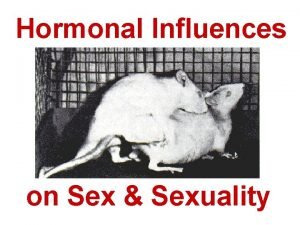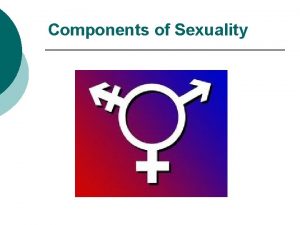Chapter 9 Sexuality Miller Intimate Relationships 6e Mc

































- Slides: 33

Chapter 9 Sexuality Miller Intimate Relationships, 6/e Mc. Graw-Hill/Irwin Copyright (c) 2012 by The Mc. Graw-Hill Companies, Inc. All rights reserved.

Science of Sex • Kinsey: Biologist, 1948 – Legitimized the study of Sex – Ethics – Subjects: Prostitutes and Gay Males – Homosexuality: 10% – Sexual Orientation 9 -2

Science of Sex • Masters and Johnson: 1960 s – Subjects: Real Couples – Method: direct observation of sex – Publication: “Human Sexual Response” (1966) -Changed the popular thinking about sex 9 -3

Pre- 1960 s Sex Myths • • • All couples have missionary sex Women are not sexual Only homosexuals have anal and oral sex Premarital sex is rare Masturbation is not normal Homosexuality not normal Most people are virgins before marriage Sexuality is black and white Extramarital sex is rare 9 -4

Masters and Johnson’s Findings • 4 Phases of Sexual Response for men/women – Excitement>Plateau>Orgasm>Refraction(men) • • • Women have multiple orgasms/not men Women (62%) and Men(92%) masturbate Women Peek sexually in 30 s Masturbation does not cause disease Homosexuality is not a disorder Heterosexuals engage in wide sexual variety 9 -5

Masters and Johnson cont’ • Treatment for premature ejaculation and impotence is possible • Premarital sex is common (over 90%) • People don’t stop having sex into 70 s, 80 s, 90 s 9 -6

Sexual Development • Gender Development: – Age 3, 4 children know their sex (boy/girl) – Age 6, 7 children’s view of their sex becomes fixed – Gender socialization starts around age 5; preferences for gender related toys, clothes, etc. – Gender Dysphoria: can develop very early in a child’s life, sex phenotype not congruent with self 9 -7

Sexual Orientation • Developmental Perspective: – Sexual Orientation consolidates in adolescence • Exploration is normal, even into early 20 s – Sexual Orientation exists on a continuum; individuals can range from primarily Homosexual/Heterosexual or Bisexual 9 -8

Need for more Research • “Non-Binary” Gender status: need for more empirical data to acknowledge and assist those who experience no dominant gender status 9 -9

Sexual Attitudes about Casual Sex Pre-Marital Casual Sex Accepted if in a Relationship In the U. S. We’re no longer expected to “save sex for marriage” as our grandparents were supposed to do. 9 -10

Sexual Attitudes about Casual Sex Men are more permissive than women, and are more accepting of casual, uncommitted sex than women are. Perhaps they can afford to be. The vestiges of a sexual double standard that judges permissive women more harshly than permissive men may still exist. 9 -11

Sexual Attitudes about Same-Sex Sexuality 80% of Americans now accept homosexual relationships as “morally acceptable. ” Tolerance is increasing, in part because the more public people are coming out of closet. People have greater familiarity with gays and lesbians. 9 -12

Sexual Attitudes Cultural Differences in Sexual Attitudes The United States holds more conservative, less permissive attitudes about: – – premarital sex teenage sex extramarital sex, and same-sex relations than do Australia, Germany, Great Britain, Israel, Russia, 9 -13 Spain, and Sweden.

Sexual Behavior Sex for the First Time • • • 95% of us have sex before marriage. The average of first intercourse is 17 for men and women. By age 20, only 15% of people have not yet had sex. The teen birth rate is much lower than it was 15 years ago. 25% of teenagers have a sexually transmitted infection Most people have sex for the first time within a steady relationship. 9 -14

Sexual Behavior Sex in Committed Relationships Spouses and cohabiting partners have sex more often than singles do. The frequency of intercourse decreases with age; older people generally have sex much less often than younger people do. 9 -15

Sexual Behavior Sexual orientation is important. Lesbians have sex less often than other couples do. In new partnerships, gay men have sex more often than anyone else, but they have less sex than heterosexual couples in the long run. 9 -16

Sexual Behavior Monogamy: Most husbands and wives never have extradyadic sex after they marry, but about 20% wives and 30% husbands do. (Not Rare!) -May contribute to high rate of divorce As you can see, men are more likely to have extramarital affairs than women are. What happens, then, in couples in which both of the partners are men? 9 -17

Sexual Behavior Gay men have more extradyadic sex than other people do. Gay culture has greater tolerance for extradyadic sex. Concept of “Open Relationships” and softer boundary between friendship and sexual relationships have greater acceptance. 9 -18

Sexual Behavior Infidelity For some of us, sex is connected to love and commitment: We only want to have sex with people we care for deeply. For others of us, “sex without love is okay”: We’re content to have sex with people whom we do not love – Extradyadic sex. These different approaches emerge from our sociosexual orientations, the beliefs and behaviors that describe our feelings about sex. 9 -19

Sexual Behavior Who engages in Infidelity? People with “restricted” sociosexual orientations: – Prefer to have sex only in the context of a close, committed relationship – Tend to have secure attachment styles – Are more committed to their romantic partners – Are less likely to have extradyadic sex 9 -20

Sexual Behavior Who engages in Infidelity? People with “unrestricted” sociosexual orientations: – – – Pursue sex in casual, uncommitted relationships Tend to be dynamic, flirtatious, sociable people Tend to be relatively uncomfortable with intimacy Are less committed to their romantic partners Are more likely to have extradyadic sex 9 -21

Sexual Behavior Monogamy at what cost? Unhappy partners more likely to be less committed -Satisfaction and Relationship Quality matters! 9 -22

Sexual Behavior Sexual Desire Men tend to have higher sex drives than women do. They experience more frequent and more intense sexual desires than women do… …and they are routinely more motivated to engage in sexual activity than women are. 9 -23

Sexual Behavior Sexual Desire Remember, sizable individual differences exist. Nevertheless: – Men masturbate more often. – Men want sex more often, and they are more likely to be dissatisfied with the amount of sex they get. – In new relationships, men want sex sooner than women do. – Men fantasize about sex more often. – Men spend more money on sex. – Men are more accepting of casual sex. 9 -24

Sexual Behavior Sexual Desire Frustration and annoyance may result as heterosexual couples negotiate their sexual interactions. Also, women are usually the “gatekeepers” who decide when sex occurs… …and they may find men willing to offer various concessions in exchange for sex. 9 -25

Sexual Behavior Safe, Sensible Sex • ¾ of college students have had hookups (casual sex, or “onenight stands” with nonromantic partners, with no expectation of a lasting relationship). • 50% of those hooking up do not use condoms when they have sex with a new or temporary partner. Why? Underestimates of risk The illusion of unique invulnerability Faulty decision making Intoxication Pluralistic ignorance Inequalities in power Abstinence education Decreased intimacy and pleasure 9 -26

Sexual Satisfaction Sex and Relationship Satisfaction Couples who are happy with their sex lives tend to be happy with their relationships, as well. Happy couples have more sex. Having more sex is tied to satisfaction too. Good sex probably makes a partnership more gratifying… …but a happy, loving relationship makes the sex better, too. 9 -27

What creates Sexual Satisfaction? Self-Determination Theory and Sexual Satisfaction Sexual interactions are most rewarding when they fulfill basic human needs for: Autonomy – Choice and control of our own actions Competence – Feeling confident and capable Relatedness – Establishing close connections to others 9 -28

Diminishing Sexual Satisfaction Too many of us are uncomfortable talking about sex, so sexual communication often presents special problems. 9 -29

Sexual Communication How do People Communicate Desire? People often never tell their partners that they’re interested in sex. They signal their desire and consent through indirect, nonverbal means. In fact, people rarely straightforwardly say, “Yes, I’d like to have sex. ” More often, they just don’t resist and don’t say “No. ” 9 -30

Sexual Communication and Satisfaction Partners who talk candidly about sex have more fulfilling sexual interactions with each other than do those who just grunt and moan now and then. That’s why Masters & Johnson (1979) argued that gays and lesbians routinely enjoy better sex with each other than most heterosexual couples do. 9 -31

Better Sex As long as we support a culture that -- regards male sexual activity as a form of conquest, -- encourages women to “play” hard-to-get, and -- trains us to be embarrassed by honest talk with a sexual partner, it will be difficult to optimize sexual experiences within intimate relationships. 9 -32

Group Work Discussion of Clinical Sex Therapy Cases: Please pick up handouts for group. Question: Discuss each case among group members. Identify concerns and recommendations. (1) Case of Sexual Addiction (2) Case of Compulsive Infidelity (3) Case of Madonna-Whore Complex 9 -33
 Family life today
Family life today Love and communication in intimate relationships
Love and communication in intimate relationships Define the relationship chapter 7
Define the relationship chapter 7 The impact of incarceration on intimate relationships
The impact of incarceration on intimate relationships Chapter 10 sex gender and sexuality
Chapter 10 sex gender and sexuality Intimate family chapter 6
Intimate family chapter 6 Intimate family chapter 6
Intimate family chapter 6 Intimate family chapter 2
Intimate family chapter 2 Intimate family chapter 2
Intimate family chapter 2 Interplanar distance formula
Interplanar distance formula Dbu writing center
Dbu writing center Medical plaza miller 131 miller street
Medical plaza miller 131 miller street Sexuality in advertising
Sexuality in advertising What are the 4 strands of sexuality
What are the 4 strands of sexuality Pretest growth development and sexuality
Pretest growth development and sexuality Awareness, acceptance, and comfort with one’s own body.
Awareness, acceptance, and comfort with one’s own body. Definition of sexuality
Definition of sexuality Definition of sexuality
Definition of sexuality Which illustrates an emotional aspect of teen sexuality?
Which illustrates an emotional aspect of teen sexuality? Peer sexuality support programme
Peer sexuality support programme Sexuality
Sexuality Sexuality spectrum
Sexuality spectrum Sex gender and sexuality
Sex gender and sexuality Difference between sex and gender
Difference between sex and gender Intimate distance is:
Intimate distance is: Frozen language examples
Frozen language examples Dewgarden foaming intimate wash benefits
Dewgarden foaming intimate wash benefits Zones of space communication
Zones of space communication Intimate zone in communication
Intimate zone in communication Intimate antonym
Intimate antonym Me line 02 intimate
Me line 02 intimate Relationship guidelines chapter 8
Relationship guidelines chapter 8 The spyware used in intimate partner violence
The spyware used in intimate partner violence Symbols in daisy miller
Symbols in daisy miller























































